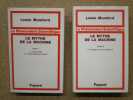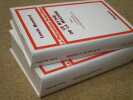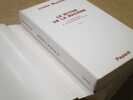-
Type
Book (3424)
Magazine (9)
-
Latest
Last 24h (6)
Last month (15)
Last week (1)
-
Language
French (3430)
Japanese (3)
-
Century
16th (18)
17th (48)
18th (208)
19th (897)
20th (1391)
21st (140)
-
Countries
Belgium (427)
China (3)
Denmark (656)
France (1171)
Italy (957)
Netherlands (2)
Switzerland (217)
-
Syndicate
ILAB (2365)
NVVA (20)
SLACES (20)
SLAM (605)
Art de prévenir et d'arreter les Incendies.
Paris, Audot, 1828. 12mo. Contemp. half calf. Gilt spine with gilt lettering. A paperlabel pasted on upper part of spine. Stamps on title-page. XII,84 pp., 1 folded engraved plate. A few minor brownspots.
Progrès les plus récents de l'éclairage et du balisage des côtes / VIIIeme congrès international de navigation Paris 1900 - 6eme Question
Imprimerie nationale 1937 in4. 1937. Broché.
Bon Etat de conservation couverture un peu défraîchie intérieur propre
arithmetique commerciale du XVe siecle: Le 'Compendy de la praticque des nombres' de Barthelemy de Romans,
Turnhout, Brepols, 2004 Hardback, 762 p., 155 x 240 mm. ISBN 9782503511962.
Le Compendy de la praticque des nombres, second traite du manuscrit S-XXVI-6 conserve a la Bibliotheque Malatestiana de Cesena en Italie, est au centre de ce travail. Il s'agit d'un traite d'algorisme affilie au groupe des "arithmetiques commerciales" francaises de la fin du Moyen Age. Ecrit au milieu du XVe siecle par le frere dominicain Barthelemy de Romans, il fut remanie par son auteur qui acheva en 1476 la redaction du texte que nous possedons. Le Compendy est un relais essentiel dans la transmission de l'algorisme. Inspire par un traite anonyme compose a Pamiers dans les premieres decennies du siecle, il a aussi puise a d'autres sources, proches du Liber abbaci de Leonard de Pise. Nicolas Chuquet s'en est par la suite fortement inspire pour les parties arithmetiques du Triparty en la science des nombres et comme fonds documentaire pour le choix des problemes. Barthelemy est un lettre, docteur en theologie, qui s'est interesse par ailleurs a la formation mathematique des marchands. Toutefois, dans le cas du Compendy, l'environnement commercial est surtout un pretexte a reflechir sur la resolution generale de quelques types de problemes lineaires. L'auteur souhaite affiner l'intelligence de ses lecteurs ; manifestement son ouvrage ne s'adresse pas au debutant et presente peu d'interet pour qui veut se former aux mathematiques du negoce. Le Compendy est une ?uvre originale et forte, a la frontiere entre manuel de pratique et essai de theorisation, qui se demarque nettement des autres arithmetiques commerciales de l'epoque. La premiere partie de ce livre est une etude autour du Compendy de la praticque des nombres, qui tente d'abord de cerner la place du traite dans le reseau des arithmetiques marchandes meridionales, puis se recentre sur les problemes lineaires privilegies par Barthelemy : analyse mathematique, regard sur les methodes, examen des sources historiques des problemes etudies. Une etude de la langue vient a la fin, qui scrute ses caracteres marquants et observe la maniere dont l'ecriture soutient a la fois des ambitions scientifiques inhabituelles et une volonte enseignante forte. La seconde partie est consacree a l'edition commentee du traite ; le texte est double d'une traduction en francais moderne pour la partie qui fait l'interet et l'originalite de l'ouvrage de Barthelemy. Languages : French.
MUDGE, JOHN. - TELESCOPE MAKING - NEWTON'S PREDICTION FULLFILLED.
Reference : 49416
(1777)
Directions for making the best Composition for the Metals of reflecting Telescopes" togethe with a Description of the Process for grinding, polishing, and giving the great Speculum the true parabolic Curve. Read Feb. 27. March 6. and 13. 1777.
(London, W. Bowyer and J. Nichols, 1777). 4to. Extracted from ""Philosophical Transactions"", Year 1777. Vol. 67 - Part I. Pp. 296-349 and 1 folded engraved plate. Wide-margined, clean and fine.
First printing of Mudge's importent paper in which he describes his new mechanical methods of making parabolic mirrors, and introducing af new composition of the alloy. Like his modern counterparts, Mudge created an apparatus to minimize the role of the technician and the possibility of errors. ""On 29 May 1777 Mudge was elected a Fellow of the Royal Society, and in the same year was awarded the Copley medal for his ‘Directions for making the best Composition for the Metals for reflecting Telescopes"" together with a Description of the Process for Grinding, Polishing, and giving the great Speculum the true Parabolic Curve,’ which were communicated by the author to the society, and printed in the Philosophical Transactions (1777, lxvii. 296). The ‘Directions’ were also issued separately by Bowyer (London, 1778). Sir John Pringle, the president, in making the presentation, remarked that Isaac Newton had predicted the role of mechanical devices in making parabolic mirrors.""(Wikipedia).
MANUALE PRATICO DI FONDERIA.
In ghisa, ghisa malleabile, alluminio, silumin, duralluminio, bronzo, ottone, leghe speciali. Seconda edizione notevolmente ampliata ed aggiornata del Manuale pratico del fonditore. Hoepli, Milano, 1928. In-16 p., cartonato editoriale (picc. spacchi ad una cerniera esterna), pp. XIX,603, con 231 ill. e numerose tabelle. Testo ben conservato.
LE GUIDE DU BRASSEUR OU L'ART DE FAIRE LA BIERE - SA COMPOSITION CHIMIQUE ET PRATIQUE
J. HETZEL ET CIE. non daté. In-12. Broché. A relier, 1er plat abîmé, Dos abîmé, Quelques rousseurs. 326 pages. Manque le dos et le second plat. Premier plat et premières pages détachées. Dos cassé, ouvrege en plusieurs parties.. . . . Classification Dewey : 663-Technologie des boissons
Bibliothèque des professions. Traduit du hollandais et annoté par L. F. Dubief. Arts et métiers, Série G. Classification Dewey : 663-Technologie des boissons
Mulhouse peint ses murs.
Mulhouse, Editions du Rhin, 1997; in-8 carré, 96 pp., cartonnage de l'éditeur. Très bon étatUne soixantaine de fresques et trompe-l"oeil signés par des artistes aux styles très divers, égaient des façades de bâtiments mulhousiens. Une classe de technologie du Collège Kennedy s"est intéressée à cet art de la rue. Chasseurs d"images passionnés, les élèves ont réalisé le livre et, à travers 130 photos commentées en couleurs, vous font découvrir un Mulhouse souvent ignoré, toujours insolite". (Postface).
Très bon étatUne soixantaine de fresques et trompe-l"oeil signés par des artistes aux styles très divers, égaient des façades de bâtiments mulhousiens. Une classe de technologie du Collège Kennedy s"est intéressée à cet art de la rue. Chasseurs d"images passionnés, les élèves ont réalisé le livre et, à travers 130 photos commentées en couleurs, vous font découvrir un Mulhouse souvent ignoré, toujours insolite". (Postface).
Thasos. Matières premières et technologie de la préhistoire à nos jours. Actes du colloque international, Thasos, Liménaria, 1995.
De Boccard / Ecole française d’Athènes, 1999. In-4, broché.
[12689]
Le mythe de la machine : la technologie et le développement humain - le pentagone de la puissance (2 volumes).
Fayard Le Phénomène Scientifique 1973 Fayard, Le Phénomène Scientifique, 2 volumes, 1973-1974, 404-643 pp, cartonnages éditeur sous jaquette, environ 22x14 cm. Quelques frottements et petites fentes sur les bords des jaquettes, le pelliculage des jaquettes a tendance à peler, une petite fente sur la coiffe inférieure du T. 1, bon état pour le reste et intérieurs bien propres.
Merci de nous contacter à l'avance si vous souhaitez consulter une référence au sein de notre librairie.
Ottoman Silk Textiles of the Royal Museum of Art and History in Brussels,
Turnhout, Brepols, 2004 Hardback, 146 pages., 16 colour ill., ills., 297 x 210 mm. FINE ISBN 9782503511863.
The aim of this catalogue is to publish the 43 Ottoman textiles which are preserved in the Royal Museums of Art and History. Except two for which we are nor sure, these specimens were woven in the major metropolitan weaving centres of the Ottoman Empire namely Bursa, Istanbul and their environs. All date from the period between the late 15th to the early 19th century. Two types of weaves are represented. Firstly the velvets of which the collection counts 25 examples, one of them being an important catma, probably the earliest preserved in the world. Follow the kemha or lampas fabrics, of which we preserve 16 specimens, 6 of them bearing inscriptions, the others decorated with various patterns. The third main type of Ottoman weaves, the seraser or cloth of gold and silver, rare in Western collections, is not represented here. Finally, the collection contains two silks in a distinctive weave, an extended tabby, of which one is a military banner. Although these fall slightly out of the otherwise homogeneous group, they where not excluded from this study because certainly produced within the Ottoman realm. This publication puts on record a status quaestionis of the knowledge we gathered the last ten years on the account of this group of silks and to place it at the disposal of other museum curators and researchers. Since the scrutiny of the weaving technology and of the natural dye analyses can lead to a better understanding of the silk industry and offers at the same time concrete elements to delimit groups of textiles and of -who knows in the future- workshops or production centres, special focus is laid on these aspects. Languages: English.
Game Theory: Analysis of Conflict
Harvard University Press 1997 568 pages 15 7x23 6x3 6cm. 1997. Broché. 568 pages.
proche du très bon état intérieur propre tranche un peu ternie
Das gelöste Problem der Aeronautik. Vergleichende Kritik der bis heute zur Lösung der aeronautischen Aufgabe in Vorschlag gebrachten Projecte, resp. Principien.
Wien, Spielhagen & Schurich, 1895. 8vo. Clothbacked boards with the orig. printed wrappers pasted on boards. A nich to frontcover. Stamp. on title-page. (4),52 pp.
Die Simplonbahn. Eine Verkehrswirtschaftliche Studie.
Bern, Stämpfli, 1907. 8°. 206 S. Orig.-Broschur.
Mit handschr. Widmung des Verfassers auf dem Titelblatt. - Broschur gebräunt und mit Einrissen, hinterer Umschlag vollständig abgelöst.
Der Eisenbahner.
2 Bände Charlottenburg, Magdeburg, Fritz Hoede, o.J. (um 1900). Lex.-8° u. quer-4°. (1) VIII, (18) 528 S.; (1) IV, (14) 542 S.; (6) S. (dv. 3 S. Zeichenerklärung). Mit 16 farb. Taf. (dv. 2 als Frontispiz), 3 Eisenbahnkarten (dv. 2 doppels.), 3 Signaltaf., 7 gef. Taf., 51 ganzs. Abb. und 206 Textabb. Farb. illustr. und gepr. Orig.-Leinenbände mit Rücken- und Deckelvergoldung
Ohne den Atlasbann. - Einband leicht berieben. Fleckig und einige Tafeln mit Einrissen. Ordentlich erhaltenes Exemplar.
Mathematisch=technisches Handbuch für Ingenieurs, Bauökonomen, Baubeamte ec. 2 Bde. in 4 Theile. (1. Reine Mathematik. Praktischer Theil. 2. Der Wasserbau. Theoretisch und Praktisch. 3. Der Strassen- und Brückenbau. 4. Die Bauökonomie. Landbau, Civilb...
Wien, Leipzig, 1841-42. Bound in 3 contemp. hcalf. Gilt spine with gilt lettering. A paperlabel pasted on upper part of spine. Stamps on title-pages. With 23 large folded lithographed plates. Some scattered brownspots.
Handbuch der Spinnerei. Mit 159 Textfiguren.
Berlin, Loewenthal, (1892). Orig. hcloth. Stamp on titlepage. II,486 pp. and 159 textfigs. Clean and fine.
(Handbuch der Mechanischen Technologie III, Abt.1).
Handbuch der Weberei (Weberei, Wirken, Flechten) mit Anhang: Nähen, Sticken und zugehörige Zurichtungsarbeiten. Mit 520 Textfiguren.
Berlin, Loewenthal, (1896). Orig. hcloth. Stamp on titlepage. X,(664) pp. and 520 textfigs. Clean and fine.
(Handbuch der Mechanischen Technologie III, Abt.2).
Forsög paa Bronce eller Guul Metal, med Hensyn til sammes Anvendelse til Canoners og Mörsers Stöbning, samt Tegning af en dertil hørende Smelteovn, m.v.
(Kbhvn., 1801). 4to. (45) pp. samt 1 stor foldet kobberstukken tavle.
(Udkom i Videnskabernes selskabs Skrifter).
Forsög paa Bronce eller guul Metal, med Hensyn til sammes Anvendelse til Canoners og Mörseres Stöbning, samt Tegning af en dertil hörende Smelteovn, m.v.
(København, Seidelin, 1803). 4to. Uden omslag som udkommet i Videnskabernes selskabs Skrifter. (55) pp. samt 1 stor udfoldelig kobberstukket planche, visende smelteovnens kontruktion.
Beschreibung einer neuen und volkommenen Art, Plans aufzunehmen, und zu verzeichnen. Mit zwölf Kupfern.
Frankfurt und Leipzig, Perrenon, 1775. Small 8vo. Contemp. hcalf. Gilt spine. Titlelabel with gilt lettering. Stamp on title-page. (4),116 pp., 12 engraved plates.
Poggendorff II,224.
Elementares Handbuch der Festigkeitslehre. Mit besonderer Anwendung auf die statische Berechnung der Eisen-Constructionen des Hochbaues, zum praktischen Gebrauch für Ingenieure, Bau-, Maurer- und Zimmermeister, sowie als Leitfaden für technische Lehra...
Berlin, Polytechnische Buchhandlung 1875. Contemp. half calf, Stamp on title. 356,82 pp. 4 folding woodcut plates.
Katalog über Apparate, Instrumente und Utensilien für den Physikalischen Unterricht an Hochschulen und höheren Lehranstalten. Sechste Auflage.
Braunschweig, 1909. 4°. XXXV, 280 S. Mit vielen Holzstichillustrationen. Originalleinwand.
Umfangreicher, reich bebilderter Firmenkatalog der auf glastechnische Konstruktionen spezialisierten Braunschweiger Firma. Beigelegt: Mitteilungslbatt Nr. 70. Dezember 1910, 4 S. - Wohlerhalten. - Selten.
AIHS, XX INTERN. CONGRESS, SECTIONS ,
Turnhout, Brepols, 1900 paperback, 155 x 240 mm. ISBN 02750011200.
Languages : English.
AIHS, XX INTERN. CONGRESS, SYMPOSIA,
Turnhout, Brepols, 1900 paperback, 155 x 240 mm. ISBN 02750012200.
Languages : English.
Revolution scientifique et libertinage,
Turnhout, Brepols, 2000 Hardback, 312 p., 155 x 240 mm. ISBN 9782503510088.
Peut-on mettre en relation - et de quelle facon ? - l'emergence et le deploiement de la science moderne, au XVIIe siecle, avec ceux du "libertinage" ou "libertinisme" pendant cette periode ? C'est a cette question complexe et quelque peu redoutable, car elle concerne les origines de notre modernite, que se sont efforces de repondre treize historiens des idees scientifiques, philosophiques ou litteraires. Il n'etait pas a l'ordre du jour - il parut meme presomptueux ou premature - d'affronter le probleme dans son abstraite generalite : il s'agissait bien plutot de mettre en lumiere, aussi precisement que possible, le cheminement intellectuel de certains hommes de science, de certains libertins averes, ou la fortune d'une idee apparemment "transversale". Ce recueil permet le reperage des nombreuses voies de rencontre qui parfois favoriserent le dialogue entre hommes de science et esprits "deniaises" au XVIIe siecle, mais aussi des obstacles qui parfois l'empecherent. Il fait peut-etre entrevoir la lente emergence d'un regime univoque de la "raison", a mesure que le siecle avance. Enfin, sa polyphonie interdisciplinaire apporte un eclairage varie sur certaines theories et notions philosophiques, comme l'atomisme et l'infini, qui jouent un role capital au XVIIe siecle. Auteurs : Armand Beaulieu, Michel Blay, Francois de Graux, Antonella Del Prete, Dominique Descotes, Vincent Jullien, Didier Kahn, Alain Mothu, Alain Niderst, Isabelle Pantin, Richard H. Popkin, Giovanni Ruocco, Bertram E. Schwarzbach, Ann Thomson. Languages : French.
 Write to the booksellers
Write to the booksellers









